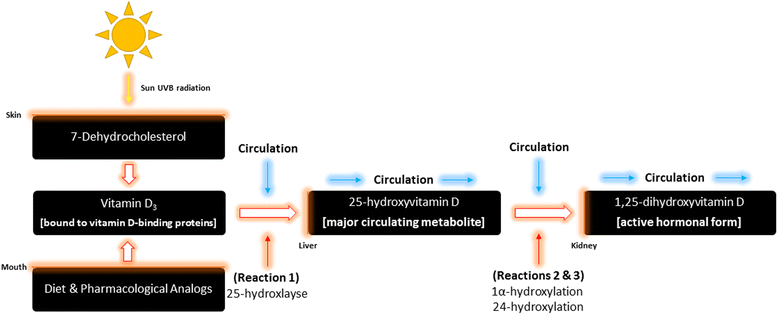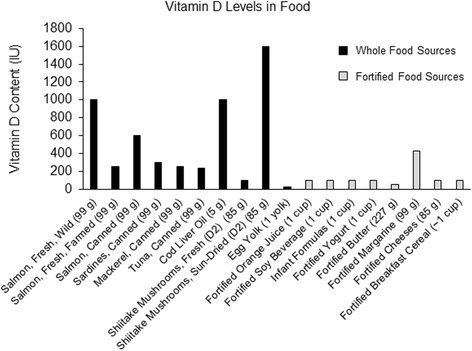Plausible ergogenic effects of vitamin D on athletic performance and recovery - PubMed (original) (raw)
Review
Plausible ergogenic effects of vitamin D on athletic performance and recovery
Dylan T Dahlquist et al. J Int Soc Sports Nutr. 2015.
Abstract
The purpose of this review is to examine vitamin D in the context of sport nutrition and its potential role in optimizing athletic performance. Vitamin D receptors (VDR) and vitamin D response elements (VDREs) are located in almost every tissue within the human body including skeletal muscle. The hormonally-active form of vitamin D, 1,25-dihydroxyvitamin D, has been shown to play critical roles in the human body and regulates over 900 gene variants. Based on the literature presented, it is plausible that vitamin D levels above the normal reference range (up to 100 nmol/L) might increase skeletal muscle function, decrease recovery time from training, increase both force and power production, and increase testosterone production, each of which could potentiate athletic performance. Therefore, maintaining higher levels of vitamin D could prove beneficial for athletic performance. Despite this situation, large portions of athletic populations are vitamin D deficient. Currently, the research is inconclusive with regards to the optimal intake of vitamin D, the specific forms of vitamin D one should ingest, and the distinct nutrient-nutrient interactions of vitamin D with vitamin K that affect arterial calcification and hypervitaminosis. Furthermore, it is possible that dosages exceeding the recommendations for vitamin D (i.e. dosages up to 4000-5000 IU/day), in combination with 50 to 1000 mcg/day of vitamin K1 and K2 could aid athletic performance. This review will investigate these topics, and specifically their relevance to athletic performance.
Keywords: Athlete; Dosage; Hormones; Performance; Recovery; Skeletal muscle; Testosterone; Vitamin D; Vitamin K.
Figures
Fig. 1
Metabolism of vitamin D3 derived from the diet, pharmacological analogs and natural sunlight to the major circulating metabolite of vitamin D (25-hydroxyvitamin D), and subsequently to the active hormonal form, 1,25 dihydroxyvtiamin D
Fig. 2
Dietary sources of vitamin D3 and D2 through whole (natural) or fortified food sources
Similar articles
- Vitamin D and skeletal muscle function in athletes.
von Hurst PR, Beck KL. von Hurst PR, et al. Curr Opin Clin Nutr Metab Care. 2014 Nov;17(6):539-45. doi: 10.1097/MCO.0000000000000105. Curr Opin Clin Nutr Metab Care. 2014. PMID: 25137505 Review. - Vitamin D, Skeletal Muscle Function and Athletic Performance in Athletes-A Narrative Review.
Książek A, Zagrodna A, Słowińska-Lisowska M. Książek A, et al. Nutrients. 2019 Aug 4;11(8):1800. doi: 10.3390/nu11081800. Nutrients. 2019. PMID: 31382666 Free PMC article. Review. - Vitamin D supplementation in athletes.
Larson-Meyer E. Larson-Meyer E. Nestle Nutr Inst Workshop Ser. 2013;75:109-21. doi: 10.1159/000345827. Epub 2013 Apr 16. Nestle Nutr Inst Workshop Ser. 2013. PMID: 23765355 - Effects of Vitamin D Supplementation on Haematological Values and Muscle Recovery in Elite Male Traditional Rowers.
Mielgo-Ayuso J, Calleja-González J, Urdampilleta A, León-Guereño P, Córdova A, Caballero-García A, Fernandez-Lázaro D. Mielgo-Ayuso J, et al. Nutrients. 2018 Dec 12;10(12):1968. doi: 10.3390/nu10121968. Nutrients. 2018. PMID: 30545134 Free PMC article. Clinical Trial. - Effects of Vitamin D on Skeletal Muscle and Athletic Performance.
Abrams GD, Feldman D, Safran MR. Abrams GD, et al. J Am Acad Orthop Surg. 2018 Apr 15;26(8):278-285. doi: 10.5435/JAAOS-D-16-00464. J Am Acad Orthop Surg. 2018. PMID: 29561306 Review.
Cited by
- Effect of Consuming Salmon Products on Vitamin D Status of Young Caucasian Women in Autumn-A Randomized 8-Week Dietary VISA 2 (Vitamin D in Salmon Part 2) Intervention Study.
Utri-Khodadady Z, Głąbska D, Guzek D. Utri-Khodadady Z, et al. Nutrients. 2024 Oct 21;16(20):3565. doi: 10.3390/nu16203565. Nutrients. 2024. PMID: 39458558 Free PMC article. Clinical Trial. - Vitamin D Supplementation Does Not Enhance Gains in Muscle Strength and Lean Body Mass or Influence Cardiorespiratory Fitness in Vitamin D-Insufficient Middle-Aged Men Engaged in Resistance Training.
Savolainen L, Timpmann S, Mooses M, Mäestu E, Medijainen L, Lellsaar M, Tiimann K, Piir A, Zilmer M, Unt E, Ööpik V. Savolainen L, et al. Nutrients. 2024 Oct 2;16(19):3356. doi: 10.3390/nu16193356. Nutrients. 2024. PMID: 39408324 Free PMC article. Clinical Trial. - The Prevalence of Low Vitamin D in Elite Para-Athletes: A Systematic Review.
Langley CK, Morse CI, Buffey AJ. Langley CK, et al. Sports Med Open. 2024 Sep 4;10(1):96. doi: 10.1186/s40798-024-00756-y. Sports Med Open. 2024. PMID: 39230661 Free PMC article. - Evaluation of Nutrition and Performance Parameters in Division 1 Collegiate Athletes.
Shoemaker ME, Dicks ND, Northrup MJ, Daughters SW, Krings TN, Barry AM. Shoemaker ME, et al. Nutrients. 2024 Jun 16;16(12):1896. doi: 10.3390/nu16121896. Nutrients. 2024. PMID: 38931251 Free PMC article.
References
- McCollum E, Simmonds N, Becker J, Shipley P. An experimental demonstration of the existence of a vitamin which promotes calcium deposition. J Biol Chem. 1922;1922:293–298. - PubMed
- Jones G. Metabolism and biomarkers of vitamin D. Scand J Clin Lab Invest. 2012;72(Suppl 243):7–13. - PubMed
- Wang T-T, Tavera-Mendoza LE, Laperriere D, Libby E, MacLeod NB, Nagai Y, et al. Large-scale in silico and microarray-based identification of direct 1,25-dihydroxyvitamin D3 target genes. Mol Endocrinol. 2005;19:2685–95. - PubMed
Publication types
MeSH terms
Substances
LinkOut - more resources
Full Text Sources
Other Literature Sources
Medical

